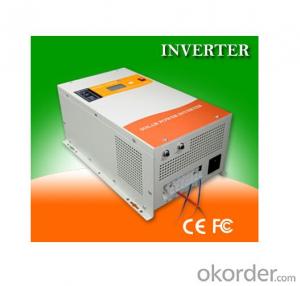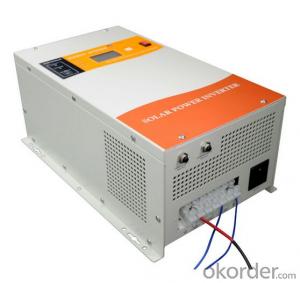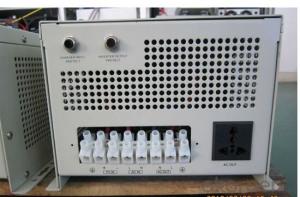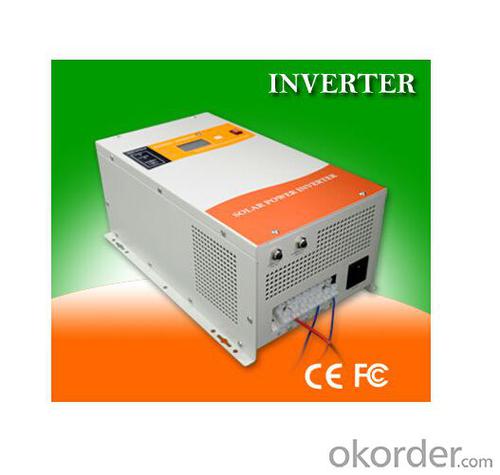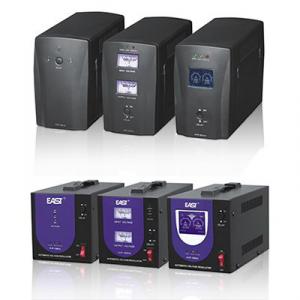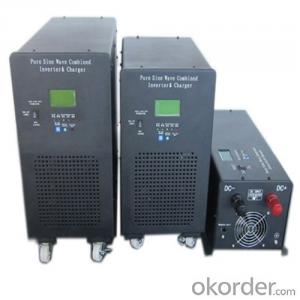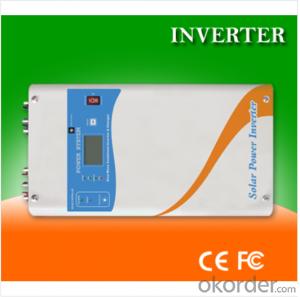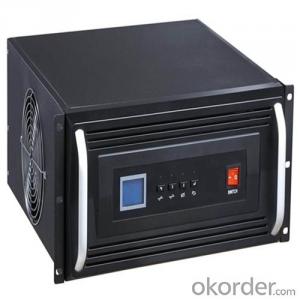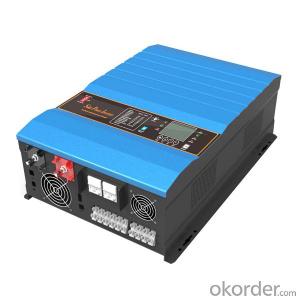30 Amp Solar Inverter 1000w 2000w 3000w Pure Sine Wave Inverter with MPPT Controller
- Loading Port:
- China main port
- Payment Terms:
- TT OR LC
- Min Order Qty:
- 10 pc
- Supply Capability:
- 10000 pc/month
OKorder Service Pledge
OKorder Financial Service
You Might Also Like
1.Specifications
1. Copper transformer
2. solar inverter
3. With Mppt charge controller
4. Pure sine wave
5. Sample available
1000w 2000w 3000w pure sine wave inverter with MPPT controller
2. Features
1.Pure sine-wave out put,can be used with different domestic appliance TV,Refrigerator,Fan,Air conditioner ,Induction cooker,micro-wave oven etc.
2. Generator compatibly and external battery connection achievable.
3. Generator compatible
Hybrid Inverter | ||
MPPT solar controller function | ||
Rated Voltage | 12/24V DC | |
Rated Charge current | 40A | |
Load current | 15A | |
Input voltage range | 15-55V DC | |
Max. PV open circuit array voltage | 55V DC | |
Typical idle consumption | At idle< 10mA | |
Overload protection(DC load) | 2.0*Inom>5s 1.5*Inom>20s 1.25*Inom temperature controlled | |
Bulk charge | 14.6V(default) | 29.2V(default) |
Floating charge | 13.4V(default) | 26.8V(default) |
Equalization charge | 14.0V(default) | 28.0V(default) |
Over charge disconnection | 14.8V | 29.6V |
Over charge recovery | 13.6V | 27.2V |
Over discharge disconnection | 10.8V(default) | 21.6V(default) |
Over discharge reconnection | 12.3V | 24.6V |
Temperature compensation | 13.2mV/C | 26.4mV/C |
Lead acid battery settings | Adjustable | |
NiCad battery settings | Adjustable | |
Load control mode | 1.Low Voltage Reconnect(LVR):Adjustable 2.Low Voltage Disconnect(LVD):Automatic disconnection 3.Reconnection:Includes warning flash before disconnect and reconnection | |
Low voltage reconnect | 12.0-14.0Vdc | 24.0-28.0Vdc |
low voltage disconnet | 10.5-12.5Vdc | 21.0-25.0Vdc |
Ambient temperature | 0-40°C(full load) 40-60°C(de-rating) | |
Altitude | Operating5000m,Non-Operating 16000m | |
Protection class | IP21 | |
Battery temperature sensor | BTS-optional remote battery temperature sensor for increased charging precision | |
Terminal size(fine/single wire) | #8 AWG | |
PV inverter battery priority | |||||||
MODEL | 1000w | 1500w | 2000w | 3000w | |||
Input Voltage Waveform | Sinusoidal (utility or generator) | ||||||
Nominal Input Voltage | 230Vac | ||||||
Low Line Disconnect | 155Vac±4% | ||||||
High Line Disconnect | 265Vac±4% | ||||||
Max AC Input Voltage | 270Vrms | ||||||
Nominal Input Frequency | 50Hz/ 60Hz (Auto detection) | ||||||
Over-Load Protection | Circuit breaker | ||||||
Output Short Circuit Protection | Circuit breaker | ||||||
Efficiency (Line Mode) | >95% | ||||||
Transfer Switch Rating | 30A | ||||||
Transfer Time(Ac to Dc) | 20ms (typical) | ||||||
Output Voltage Waveform | Sine wave | ||||||
Rated Output Power (W) | 1000W | 1500W | 1500W | 2000W | 2000W | 3000W | 3000W |
Power Factor | 1 | ||||||
Nominal Output Voltage (V) | 230Vac | ||||||
Output Voltage Regulation | ±10% rms | ||||||
Nominal Efficiency | >80% | ||||||
Nominal DC Input Voltage | 12V | 12V | 24V | 12V | 24V | 12V | 24V |
Nominal Charge Current | 35A | 45A | 35A | 65A | 35A | 75A | 45A |
Charge Current Regulation | ± 5A | ||||||
Battery initial voltage | 0 –15.7 Vdc /31.4Vdc(can operate with 0V battery) | ||||||
Communication: | RJ11 (Used for factory testing. No customer interface available) | ||||||
Safety Certification | CE(EN60950) | ||||||
EMI Classification | EN50091-2, CLASS A | ||||||
Operating Temperature Range | 0°C to 40°C | ||||||
Storage temperature | -15ºC ~ 60ºC | ||||||
Operation humidity | 5% to 95% | ||||||
Audible Noise | 60dB max | ||||||
Cooling | Forced air, variable speed fan | ||||||
3.FAQ
Q1: How to choose a right inverter?
A1:Tell us your demand, then our sales will recommend a suitable inverter to you.
Q2: What's the different between inverter and solar inverter?
A2: Inverter is only accept AC input, but solar inverter not only accept AC input but also can connect with solar panel to accept PV input, it more save power.
Q3: How about the delivery time?
A3: 7 days for sample; 25 days for bulk order.
Q4: What is the warranty of inverter?
A4: One year warranty on Must-Solar product.
Q5: How to solve the technical problem?
A5: 24 hours after-service consultancy just for you and to make your problem to solve easily.
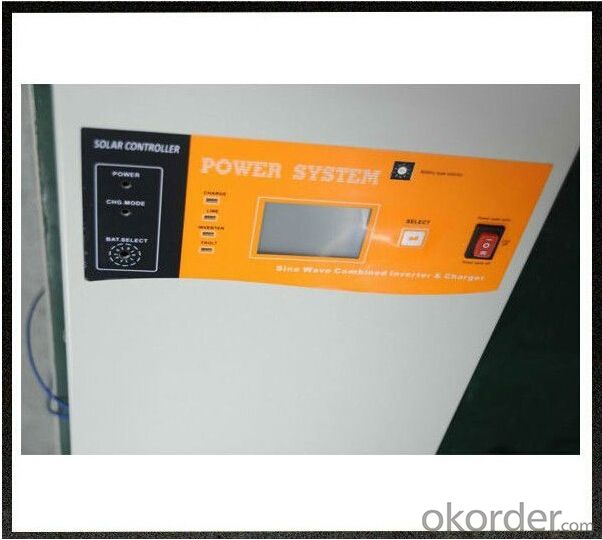
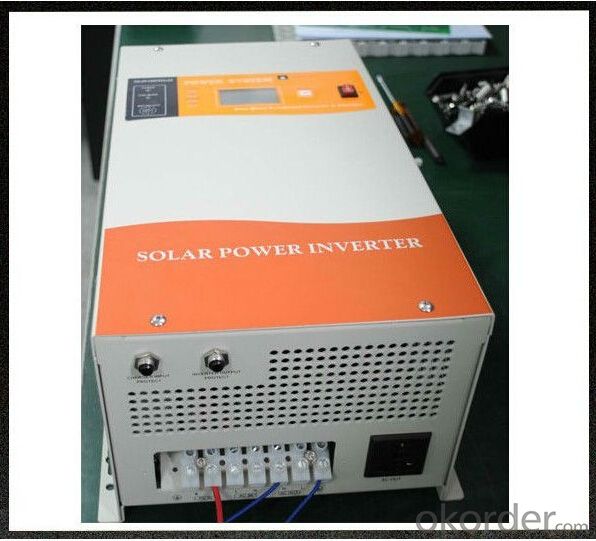
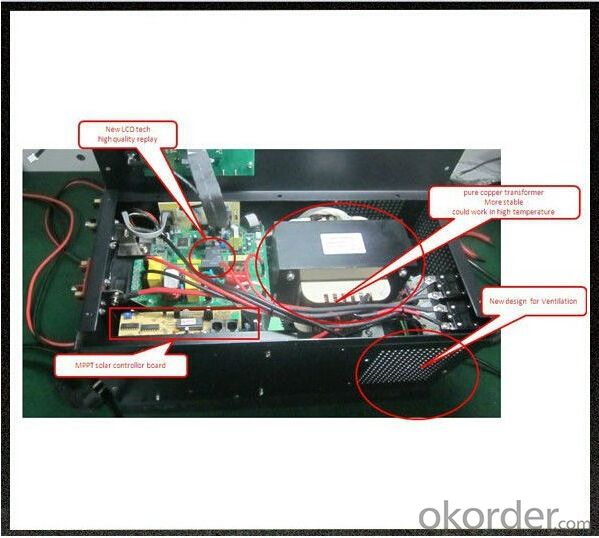
- Q: How do you calculate the maximum power point current for a solar inverter?
- To calculate the maximum power point current for a solar inverter, you need to determine the maximum power point voltage (Vmpp) of the solar panel and divide it by the inverter's input impedance. This can be done by using the voltage-current (V-I) curve of the solar panel and locating the point where the product of voltage and current is maximized. By obtaining the Vmpp value, you can then calculate the maximum power point current by dividing it by the inverter's input impedance.
- Q: How does a solar inverter handle grid frequency deviations?
- A solar inverter handles grid frequency deviations by constantly monitoring the grid frequency. When the grid frequency deviates from the standard range, the inverter adjusts its output frequency accordingly to match the grid frequency. This allows the inverter to maintain synchronization with the grid and continue injecting power efficiently, ensuring stability and reliability of the solar power system.
- Q: How does a solar inverter handle voltage fluctuations from the solar panels?
- A solar inverter handles voltage fluctuations from the solar panels by continuously monitoring the incoming voltage and adjusting its own output voltage accordingly. It employs a control mechanism that stabilizes the voltage to ensure compatibility with the utility grid or the connected appliances. This enables the solar inverter to efficiently convert the variable DC voltage from the solar panels into a stable AC voltage, maintaining a consistent and reliable power supply.
- Q: Can a solar inverter be used with different brands of solar panels?
- Yes, a solar inverter can generally be used with different brands of solar panels as long as the panels have compatible voltage and power ratings. However, it is recommended to consult the manufacturer's specifications and guidelines to ensure compatibility and optimal performance.
- Q: What is the role of a solar inverter in power factor correction?
- The role of a solar inverter in power factor correction is to convert the direct current (DC) generated by the solar panels into alternating current (AC) that can be used by the electrical grid. In doing so, the solar inverter ensures that the AC power being fed into the grid has a power factor close to unity, which means it is efficient and does not cause any unnecessary strain on the electrical system. This helps to improve the overall power quality and efficiency of the solar energy system.
- Q: What is the warranty period for a solar inverter?
- The warranty period for a solar inverter can vary depending on the manufacturer and model, but it typically ranges from 5 to 10 years.
- Q: What is the role of an anti-islanding feature in a solar inverter?
- The role of an anti-islanding feature in a solar inverter is to ensure the safety of utility workers during power outages. It detects when the grid goes down and immediately disconnects the solar system from the grid to prevent the flow of electricity back into the grid. This prevents the potential danger of utility workers being exposed to live electricity while working on the grid.
- Q: How does a solar inverter affect the overall efficiency of a solar system?
- A solar inverter plays a crucial role in the overall efficiency of a solar system. It converts the direct current (DC) generated by solar panels into alternating current (AC) that can be used to power household or commercial appliances. By ensuring optimal conversion efficiency and minimizing power losses during this process, a high-quality solar inverter can significantly impact the overall efficiency of a solar system.
- Q: How does the size of a solar inverter affect its performance?
- The size of a solar inverter directly impacts its performance. A larger inverter with a higher wattage capacity can handle a greater amount of solar power generated by the panels. On the other hand, a smaller inverter may not be able to efficiently convert and utilize all the energy produced, resulting in a decrease in overall system performance. Therefore, choosing the appropriate size solar inverter is crucial to ensure optimal performance and maximize energy production.
- Q: Can a solar inverter be used with solar-powered irrigation systems?
- Yes, a solar inverter can be used with solar-powered irrigation systems. A solar inverter is used to convert the direct current (DC) power generated by solar panels into alternating current (AC) power that can be used to operate electrical devices. In the case of solar-powered irrigation systems, the solar inverter would be used to convert the DC power produced by the solar panels into AC power to run the irrigation pumps and other electrical components of the system. This allows for efficient and sustainable operation of the irrigation system using solar energy.
Send your message to us
30 Amp Solar Inverter 1000w 2000w 3000w Pure Sine Wave Inverter with MPPT Controller
- Loading Port:
- China main port
- Payment Terms:
- TT OR LC
- Min Order Qty:
- 10 pc
- Supply Capability:
- 10000 pc/month
OKorder Service Pledge
OKorder Financial Service
Similar products
Hot products
Hot Searches
Related keywords
